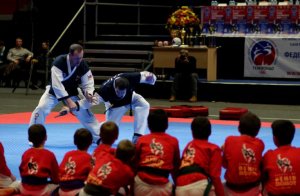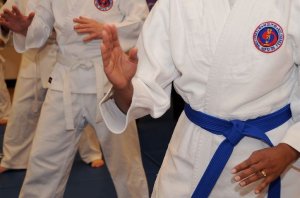Benefits of Hapkido

Although its origins are ancient, Hapkido is becoming more and more popular. Not only as a self-defense technique but also as a complete exercise for the body and mind. Next, we’ll take a closer look at Hapkido and what are its health benefits are.
What is Hapkido?
We must not confuse Hapkido with sports or gymnastics classes. The goal is not to have a more muscular body or compete for points. It’s a martial art that involves a remarkable discipline and ethical values, to achieve an effective personal defense.
It originates from Korea and was founded in 1948 by Choi Young Sul. Its objective is to generate an applied science that can be transmitted as a discipline for self-defense. In this way, all the techniques and styles of attack that are employed are aimed at achieving the survival of the practitioner.

For this, Hapkido focuses its methods on the effective management of pressure points and joints. Combining defensive and offensive movements, the individual must be able to disable the attacker quickly and efficiently. Individuals must be able to defend themselves safely.
As an educational method, Hapkido combines various principles of other secular martial arts. Among these, we find Karate, Judo, Aikido, Kung Fu and Tae Kwon Do. It also uses weapon management techniques from Kumdo and Ninjutsu.
The body-mind balance: the basis of Hapkido
The execution of its methods can cause serious injuries and, in extreme cases, have consequences for the attacker’s health. Therefore, its practice shouldn’t be approached as a method of weight control or muscle toning. Remember, it’s a martial art and not a sport.
The objective of their techniques is to cancel the attack and control the aggressor effectively to ensure survival. At all times, it’s about avoiding unnecessary injuries or encouraging aggressive behavior.
Hapkido participants must use self-confidence and self-control to apply the methods in a responsible, safe and professional manner. Otherwise, the practice becomes dangerous.
Therefore, the student’s mind and body must be in good condition. Cognitive, emotional and social abilities must be in perfect synchrony with physical strength.
Benefits of Hapkido
Like all martial arts, Hapkido includes intense physical preparation and a balance between the mind and body. The knowledge of different techniques for personal defense implies an enormous responsibility and respect for ethical values.
For this reason, the practice of Hapkido is usually positive for adolescents. Physical work has a positive impact on growth, helping to strengthen muscles and improve flexibility. It also fosters self-knowledge about every part of the body.
But, the greatest benefit is the principles of behavior and concentration required by the discipline. When practicing Hapkido or another martial art, young people make contact and see the practical value of many ethical bases.

Students in this discipline learn the need for self-control for coexistence in society and have the opportunity to improve their self-esteem and self-confidence. This is fundamental to avoid the typical insecurities of adolescence.
Martial arts such as Hapkido teach children, youths, and adults to channel their energy positively. In times of haste and increasing stress levels, this is crucial to prevent behavioral problems and symptoms of anxiety, fear or stress.
Moreover, people of all ages can discover the importance of teamwork and perseverance in Hapkido. The perfect execution of each technique and movement requires dedication. It also needs study and, above all, humility to keep improving and learning constantly. It’s a great education for young people.
Although its origins are ancient, Hapkido is becoming more and more popular. Not only as a self-defense technique but also as a complete exercise for the body and mind. Next, we’ll take a closer look at Hapkido and what are its health benefits are.
What is Hapkido?
We must not confuse Hapkido with sports or gymnastics classes. The goal is not to have a more muscular body or compete for points. It’s a martial art that involves a remarkable discipline and ethical values, to achieve an effective personal defense.
It originates from Korea and was founded in 1948 by Choi Young Sul. Its objective is to generate an applied science that can be transmitted as a discipline for self-defense. In this way, all the techniques and styles of attack that are employed are aimed at achieving the survival of the practitioner.

For this, Hapkido focuses its methods on the effective management of pressure points and joints. Combining defensive and offensive movements, the individual must be able to disable the attacker quickly and efficiently. Individuals must be able to defend themselves safely.
As an educational method, Hapkido combines various principles of other secular martial arts. Among these, we find Karate, Judo, Aikido, Kung Fu and Tae Kwon Do. It also uses weapon management techniques from Kumdo and Ninjutsu.
The body-mind balance: the basis of Hapkido
The execution of its methods can cause serious injuries and, in extreme cases, have consequences for the attacker’s health. Therefore, its practice shouldn’t be approached as a method of weight control or muscle toning. Remember, it’s a martial art and not a sport.
The objective of their techniques is to cancel the attack and control the aggressor effectively to ensure survival. At all times, it’s about avoiding unnecessary injuries or encouraging aggressive behavior.
Hapkido participants must use self-confidence and self-control to apply the methods in a responsible, safe and professional manner. Otherwise, the practice becomes dangerous.
Therefore, the student’s mind and body must be in good condition. Cognitive, emotional and social abilities must be in perfect synchrony with physical strength.
Benefits of Hapkido
Like all martial arts, Hapkido includes intense physical preparation and a balance between the mind and body. The knowledge of different techniques for personal defense implies an enormous responsibility and respect for ethical values.
For this reason, the practice of Hapkido is usually positive for adolescents. Physical work has a positive impact on growth, helping to strengthen muscles and improve flexibility. It also fosters self-knowledge about every part of the body.
But, the greatest benefit is the principles of behavior and concentration required by the discipline. When practicing Hapkido or another martial art, young people make contact and see the practical value of many ethical bases.

Students in this discipline learn the need for self-control for coexistence in society and have the opportunity to improve their self-esteem and self-confidence. This is fundamental to avoid the typical insecurities of adolescence.
Martial arts such as Hapkido teach children, youths, and adults to channel their energy positively. In times of haste and increasing stress levels, this is crucial to prevent behavioral problems and symptoms of anxiety, fear or stress.
Moreover, people of all ages can discover the importance of teamwork and perseverance in Hapkido. The perfect execution of each technique and movement requires dedication. It also needs study and, above all, humility to keep improving and learning constantly. It’s a great education for young people.
This text is provided for informational purposes only and does not replace consultation with a professional. If in doubt, consult your specialist.








